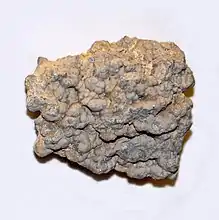| Solenopora Temporal range: | |
|---|---|
 | |
| Fossils of Solenopora species | |
| Scientific classification | |
| (unranked): | Archaeplastida |
| Division: | Rhodophyta |
| Class: | Florideophyceae |
| Stem group: | Corallinales |
| Family: | †Solenoporaceae Pia, 1927 [2] |
| Genus: | †Solenopora Dybowski, 1877 |
| Species[3] | |
| |
The extinct Solenoporaceae have traditionally been interpreted as a group of red algae ancestral to the Corallinales.[4]
The genus from which they take their name, Solenopora, originates in the Ordovician.[5] Unlike the Corallinaceae, this family has large vegetative cells and an undifferentiated thallus.[5] Additionally there are external, non-calcified sporangia.[6]
The differences in structure suggest that the holotype is not an alga at all, but rather is a chaetetid sponge. Post-Palaeozoic specimens therefore require re-classification.[7] However, some algal taxa are still classified within the genus.[8]
Some specimens of algal Solenopora retain an original pink colouration, which is banded with growth stages of the fossil; this is produced by boron-containing hydrocarbons.[8]
The solenoporaceae mineralized with calcite.[9]
Other genera within the Solenoporaceae
Although the following other genera have been included in this family, their status is uncertain due to the loose definition of the family.[3][7]
- Dendronella Moussavian and Senowbari-Daryan 1988
- Elianella
- Marinella Pfender 1939
- Metasolenopora Pia 1930
- Parachaetetes Deninger 1906
- Pycnoporidium Yabe and Toyama 1928
- Solenoporella Rothpletz
- Tauristorea Senowbari-Daryan and Link 2005
See also
- Coralline algae#Evolution
- Other stem-group corallines:
- Arenigiphyllum (Ordovician)
- Petrophyton (Ordovician : Caradoc)
- Graticula (Silurian : Wenlock)
- Halysis (Ordovician)
- Archaeolithophyllum (Pennsylvanian)
- ?Maimonachaetetes (Mississippian)
- ?Palaeoaplysina (Pennsylvanian – Permian; possibly an animal)
- ? Solenoporaceae (Ordovician)
References
- ↑ Wright, V. P. (1 May 1985). "Seasonal Banding in the Alga Solenopora jurassica from the Middle Jurassic of Gloucestershire, England". Journal of Paleontology. 59 (3): 485–792. Bibcode:1974JPal...48..524M. ISSN 0022-3360. JSTOR 1304992.
- ↑ Max Hirmer; Julius Pia et al , 1927 Handbuch der Paläobotanik München : Verlag von R. Oldenbourg
- 1 2 Paleobiology Database
- ↑ Johnson, J. H. (May 1956). "Ancestry of the Coralline Algae". Journal of Paleontology. 30 (3): 563–567. ISSN 0022-3360. JSTOR 1300291.
- 1 2 Blackwell, W. H.; Marak, J. H.; Powell, M. J. (1982). "The Identity and Reproductive Structures of a Misplaced Solenopora (Rhodophycophyta) from the Ordovician of Southwestern Ohio and Eastern Indiana1". Journal of Phycology. 18 (4): 477–482. doi:10.1111/j.0022-3646.1982.00477.x.
- ↑ Lee, R. E. (1999). Phycology. Cambridge University Press. p. 158. ISBN 978-0-521-63883-8.
Solenoporaceae.
- 1 2 Riding, R. (2004). "Solenopora is a Chaetetid Sponge, Not an Alga". Palaeontology. 47: 117–122. doi:10.1111/j.0031-0239.2004.00351.x.
- 1 2 Wolkenstein, K.; Gross, J. H.; Falk, H. (2010). "Boron-containing organic pigments from a Jurassic red alga". Proceedings of the National Academy of Sciences. 107 (45): 19374–19378. Bibcode:2010PNAS..10719374W. doi:10.1073/pnas.1007973107. PMC 2984207. PMID 20974956.
- ↑ Cozar, P.; Vachard, D. (2006). "A new Mississippian red alga from south-western Spain". Geobios. 39 (6): 791. doi:10.1016/j.geobios.2005.09.002.